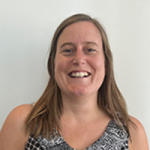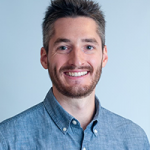 Linda J. Harrison is a research scientist at the Center for Biostatistics in AIDS Research within the Harvard T.H. Chan School of Public Health. She holds a bachelor’s degree in mathematics from Oxford University and a master’s degree in medical statistics from the London School of Hygiene and Tropical Medicine.
Linda J. Harrison is a research scientist at the Center for Biostatistics in AIDS Research within the Harvard T.H. Chan School of Public Health. She holds a bachelor’s degree in mathematics from Oxford University and a master’s degree in medical statistics from the London School of Hygiene and Tropical Medicine.
 Dustin J. Rabideau is the associate director of biostatistics and strategic initiatives at Massachusetts General Hospital and an assistant professor of medicine at Harvard Medical School. He holds a bachelor’s degree from the State University of New York College at Geneseo and a master’s degree in biostatistics from Harvard. He spent four years at Massachusetts General Hospital before returning to Harvard to pursue a PhD in biostatistics.
Dustin J. Rabideau is the associate director of biostatistics and strategic initiatives at Massachusetts General Hospital and an assistant professor of medicine at Harvard Medical School. He holds a bachelor’s degree from the State University of New York College at Geneseo and a master’s degree in biostatistics from Harvard. He spent four years at Massachusetts General Hospital before returning to Harvard to pursue a PhD in biostatistics.
Being a biostatistician is a rewarding experience. Working at the intersection of math, biology, health care, and data science, a biostatistician applies rigorous mathematical and scientific thinking to solve real-world problems in medicine and public health. Biostatisticians have diverse careers collaborating with scientists across a range of disciplines on research study design and data analysis. According to the National Center for Education Statistics, more people are choosing to pursue and advance careers in biostatistics and health data science.
Many professional positions in biostatistics require at least a master’s degree in the subject. A supportive environment and access to opportunities in varied research projects allow for an energizing lifelong career. We both had incredible experiences working as master’s-level biostatisticians for several years in collaborative biostatistical centers and benefitted from research experience that enabled independent work and self-initiated projects. The next step we took to access further professional growth in the academic setting was to pursue PhDs in biostatistics.
Choosing to leave your rewarding job to spend about five years as a student can be a difficult decision. Not only is there typically a considerable pay cut, there is also the humbling experience of retaking coursework you perhaps once grasped but now need to grasp again to thrive in the methodological arena, which is the focus of many biostatistics PhD curricula. Nonetheless, a deeper understanding of technical concepts and an inherent statistical intuition are ingrained during the PhD program. The PhD dissertation component provides an excellent opportunity to dedicate focused time to a research topic of interest—an experience we both found fulfilling. Yet, the educational journey does not end there. Once a PhD is completed, the transition back into the collaborative work environment begins.
After completing our PhDs, we both chose to return to our previous biostatistical centers. This presented unique challenges that a transition to another organization may not have had. First, the potential career trajectory of a PhD-level biostatistician in the academic setting is different than that of a master’s-level biostatistician. For us, this meant former colleagues now viewed us (or needed to be encouraged to view us) through a different lens. This took some getting used to.
Although much of our day-to-day work felt familiar, it was difficult to not return to collaborative work that had moved on in the five or so years it took us to complete PhDs, though new opportunities presented themselves. We took on more administrative leadership responsibilities within our centers and more of a scientific leadership role in our collaborative research projects. Though uncomfortable at times, we found it important—and ultimately fulfilling—to embrace these fresh opportunities with a positive, confident, and head-first attitude.
The transition from master’s- to PhD-level biostatistician required us to establish new collaborative relationships in new medical areas and build our research interests again. This was enlightening, since when you develop a research path for a second time, you have different interests. More varied prospects present themselves, and you are more confident in your statistical thinking. One of the benefits of being a biostatistician in a collaborative environment is the diverse range of scientific areas you encounter, so your skill set and knowledge base is continuously diversified and enhanced.
Here are some reflections and tips for others who may be working with a master’s degree and considering a PhD, studying for a PhD after considerable work experience, or transitioning to positions after a PhD, especially those returning to their prior institutions:
- The more you research, study, and find yourself in different roles, the more you learn, and the more aware you are of what you don’t know. This can be a discomforting part of being a biostatistician yet an integral part of research.
- Try to take classes while you are a master’s-level biostatistician and, upon your return to work after completing a PhD, try to take or teach classes. Taking classes before your PhD will prepare you for PhD coursework and help with the transition back to school. Taking and teaching classes after the PhD allow you to use your PhD skill set, which can ease the transition back to a collaborative work environment.
- Biostatistics requires both painstaking, detail-oriented, and focused work and big-picture thinking about research ideas. Somewhere along the way, the balance will be off (e.g., your simulation code is off by a tiny detail, and you can’t figure out where, or your simulations run successfully, but you have no idea if the results answer an interesting question). Getting the balance right comes and goes, and persistence is key.
- When beginning new collaborations, especially those in new medical areas, indulge your curiosity. Ask many questions, even if they appear trivial or completely unrelated to statistical considerations. The deeper you dive into your collaborators’ field, the more enjoyment and success you’ll find in the research partnership.
- As administrative, leadership, and supervisory responsibilities increase, be sure to maintain regularly scheduled time to exercise your statistical and technical abilities. Set aside protected time each day or week to think about statistical theory, write code for an analysis, or read that statistics paper that’s been sitting on your desktop for months.
- Last, have confidence in your chosen path. In different roles, others may perceive you differently, which has its advantages and disadvantages. Finding the advantages takes an evolving positive outlook on the opportunities you have.




Leave a Reply